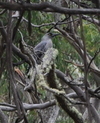Genus Strepera
Black Currawong - The Black Currawong was first described by ornithologist John Gould in 1837.
Pied Currawong - Within its range, the Pied Currawong is generally sedentary, although populations at higher altitudes relocate to lower areas during the cooler months. It is omnivorous, with a diet that includes a wide variety of berries and seeds, invertebrates, bird eggs and juvenile birds. It is a predator which has adapted well to urbanization and can be found in parks and gardens as well as rural woodland. The habitat includes all kinds of forested areas, although mature forests are preferred for breeding. Roosting, nesting and the bulk of foraging take place in trees, in contrast with the ground foraging behaviour of its relative the Australian Magpie.
Grey Currawong - Within its range, the Grey Currawong is generally sedentary, although it is a winter visitor in the southeastern corner of Australia. Comparatively little studied, much of its behaviour and habits is poorly known. Omnivorous, it has a diet that includes a variety of berries, invertebrates, and small vertebrates. Less arboreal than the Pied Currawong, the Grey Currawong spends more time foraging on the ground. It builds nests high in trees, which has limited the study of its breeding habits. Unlike its more common relative, it has adapted poorly to human impact and has declined in much of its range. The habitat includes all kinds of forested areas as well as scrubland in dryer parts of the country.



